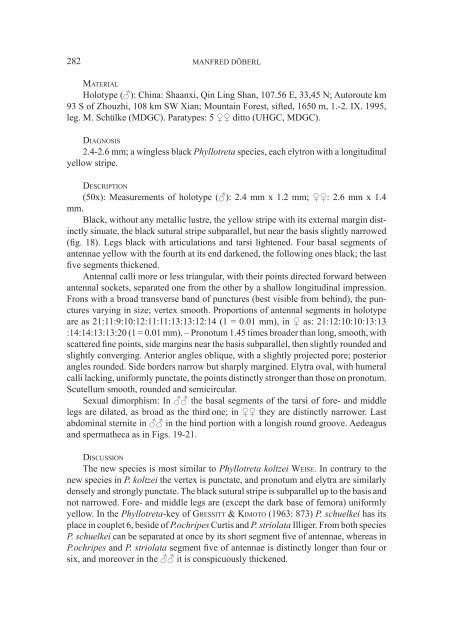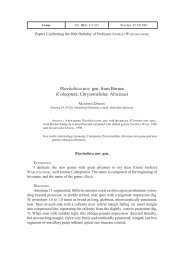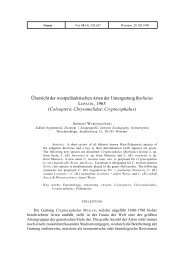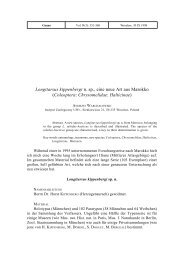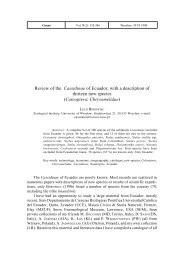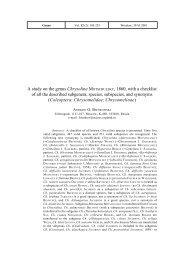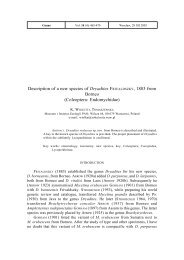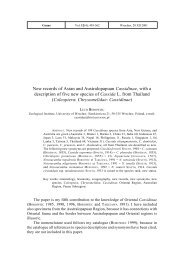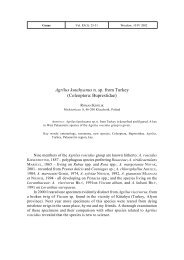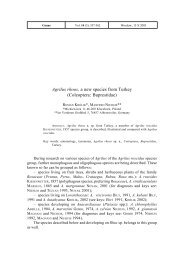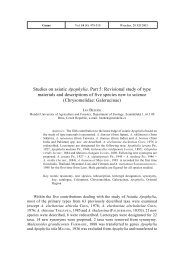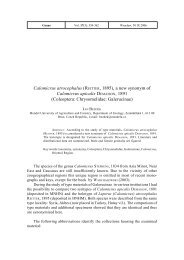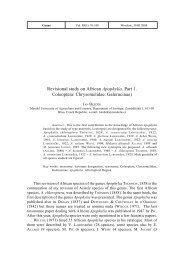New Alticinae from China and southeastern Asia (Coleoptera ...
New Alticinae from China and southeastern Asia (Coleoptera ...
New Alticinae from China and southeastern Asia (Coleoptera ...
Create successful ePaper yourself
Turn your PDF publications into a flip-book with our unique Google optimized e-Paper software.
282 MANFrED DöBErL<br />
Material<br />
Holotype (♂): <strong>China</strong>: Shaanxi, Qin Ling Shan, 107.56 E, 33,45 N; Autoroute km<br />
93 S of Zhouzhi, 108 km SW Xian; Mountain Forest, sifted, 1650 m, 1.-2. IX. 1995,<br />
leg. M. Schülke (MDGC). Paratypes: 5 ♀♀ ditto (uHGC, MDGC).<br />
diagnosis<br />
2.4-2.6 mm; a wingless black Phyllotreta species, each elytron with a longitudinal<br />
yellow stripe.<br />
description<br />
(50x): Measurements of holotype (♂): 2.4 mm x 1.2 mm; ♀♀: 2.6 mm x 1.4<br />
mm.<br />
Black, without any metallic lustre, the yellow stripe with its external margin distinctly<br />
sinuate, the black sutural stripe subparallel, but near the basis slightly narrowed<br />
(fig. 18). Legs black with articulations <strong>and</strong> tarsi lightened. Four basal segments of<br />
antennae yellow with the fourth at its end darkened, the following ones black; the last<br />
five segments thickened.<br />
Antennal calli more or less triangular, with their points directed forward between<br />
antennal sockets, separated one <strong>from</strong> the other by a shallow longitudinal impression.<br />
Frons with a broad transverse b<strong>and</strong> of punctures (best visible <strong>from</strong> behind), the punctures<br />
varying in size; vertex smooth. Proportions of antennal segments in holotype<br />
are as 21:11:9:10:12:11:11:13:13:12:14 (1 = 0.01 mm), in ♀ as: 21:12:10:10:13:13<br />
:14:14:13:13:20 (1 = 0.01 mm). – Pronotum 1.45 times broader than long, smooth, with<br />
scattered fine points, side margins near the basis subparallel, then slightly rounded <strong>and</strong><br />
slightly converging. Anterior angles oblique, with a slightly projected pore; posterior<br />
angles rounded. Side borders narrow but sharply margined. Elytra oval, with humeral<br />
calli lacking, uniformly punctate, the points distinctly stronger than those on pronotum.<br />
Scutellum smooth, rounded <strong>and</strong> semicircular.<br />
Sexual dimorphism: In ♂♂ the basal segments of the tarsi of fore- <strong>and</strong> middle<br />
legs are dilated, as broad as the third one; in ♀♀ they are distinctly narrower. Last<br />
abdominal sternite in ♂♂ in the hind portion with a longish round groove. Aedeagus<br />
<strong>and</strong> spermatheca as in Figs. 19-21.<br />
discussion<br />
The new species is most similar to Phyllotreta koltzei Weise. In contrary to the<br />
new species in P. koltzei the vertex is punctate, <strong>and</strong> pronotum <strong>and</strong> elytra are similarly<br />
densely <strong>and</strong> strongly punctate. The black sutural stripe is subparallel up to the basis <strong>and</strong><br />
not narrowed. Fore- <strong>and</strong> middle legs are (except the dark base of femora) uniformly<br />
yellow. In the Phyllotreta-key of gressitt & kiMoto (1963: 873) P. schuelkei has its<br />
place in couplet 6, beside of P.ochripes Curtis <strong>and</strong> P. striolata Illiger. From both species<br />
P. schuelkei can be separated at once by its short segment five of antennae, whereas in<br />
P.ochripes <strong>and</strong> P. striolata segment five of antennae is distinctly longer than four or<br />
six, <strong>and</strong> moreover in the ♂♂ it is conspicuously thickened.


